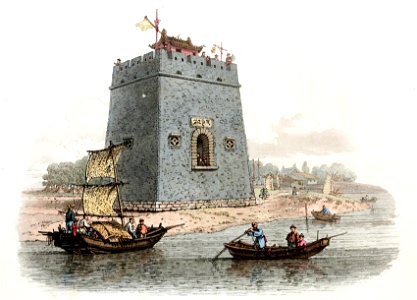Drawing by william alexander, draughtsman of the macartney embassy to china in 1793. A fort near tianjin situated on a point at the confluence of three rivers, the pei-ho, the yun-leang, and the when-ho. The city of tianjin was carefully guarded since it was the chief harbor for shipping, and principal depot for merchandise in china. This fortification was thirty-five feet in height, and built with bricks, except the foundation, which was of stone, and has been partly undermined; the surrounding country being very low and marshy. A guard of soldiers was constantly stationed there, and, in cases of turmoil, the sentinels gave the alarm to the adjacent military posts, in the daytime by hoisting a signal, and at night by the explosion of fireworks; on which the neighboring garrisons would arrive to the spot. On the upper landing there is a building to shelter sentinels on duty; one of them is beating a gong, to announce to the garrison the approach of a viceroy or mandarin of rank; on this notice, they immediately form in a rank, and stand under arms to salute him. Within the parapet a lantern is suspended, and in the opposite angle the imperial standard is elevated; the color of the tablet, with the inscription on it, likewise shows it to be a royal edifice. In johan nieuhoff's account of the dutch embassy, which was sent to peking in the year of 1650, there is a print either of this tower, or one similar to it, which stood on the same site. The hillocks of earth under a clump of trees, seen in the distance, are burying-places. Image taken from the costume of china, illustrated in forty-eight coloured engravings, published in london in 1805. Date: circa 1800.
Loading...
